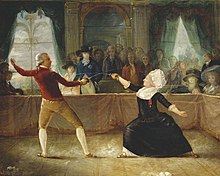Abbé Alexandre-Auguste Robineau

Abbé Alexandre-Auguste Robineau (23 April 1747, in Paris – 13 January 1828, in Paris) was a French painter, composer, violinist, conductor, and Catholic priest. As a composer he wrote under the name Alexandre Robineau, and as a painter he painted under the name Auguste Robineau.
Life and career
Born in Paris to the engraver, painter and jeweller Jean-Charles Robineau and his wife Madeleine-Charlotte Regnier, Robineau studied music composition and the violin with Pierre Gaviniès and painting with his father in his native city. In 1754, at the age of seven, he became a choirboy at the Sainte-Chapelle where he later took holy orders. From 1762-1767 he studied music in Italy, primarily at the Conservatorio di Santa Maria di Loreto as a violin and composition pupil of Antonio Lolli.[1]
A brilliant violinist, Robineau performed often in the Concert Spirituel, one of the first public concert series in existence, after returning to Paris in late 1767.[1] His performances often included his own compositions, which included several violin concertos (now lost) and a few sonatas for violin and double bass which were composed in 1768. He served as the secretary of the Menus-Plaisirs du Roi from 1785 until the outbreak of the French Revolution in 1789.[2] During this time he traveled to London where he came in contact with the Prince George of Wales (later King George IV), whom he played music and painted for.[1]
From 1789-1792 Robineau was the conductor of the orchestra at the Théâtre-Français.[2] He died in 1828 in Paris.[1] His portrait of composer Niccolò Piccinni, which for many years was housed at the Palais Garnier, is currently part of the collection at the Musée de la musique in Paris.[3]
References
- ^ a b c d Neal Zaslaw, ed Stanley Sadie, "Robineau, Abbé Alexandre-Auguste (1747 - 1828), violinist, composer, painter", The New Grove Dictionary of Music and Musicians, First Edition (London: Macmillan, 1980), 20 vols. ISBN 0-333-23111-2
- ^ a b Zdenko Silvela (2003). Historia del violin. Entrelineas Editores. p. 503. ISBN 9788496190382.
- ^ Istituto di bibliografia musicale di Puglia (2004). Niccolò Piccinni, musicista europeo. M. Adda. p. 294.
External links
 Media related to Alexandre-Auguste Robineau at Wikimedia Commons
Media related to Alexandre-Auguste Robineau at Wikimedia Commons
